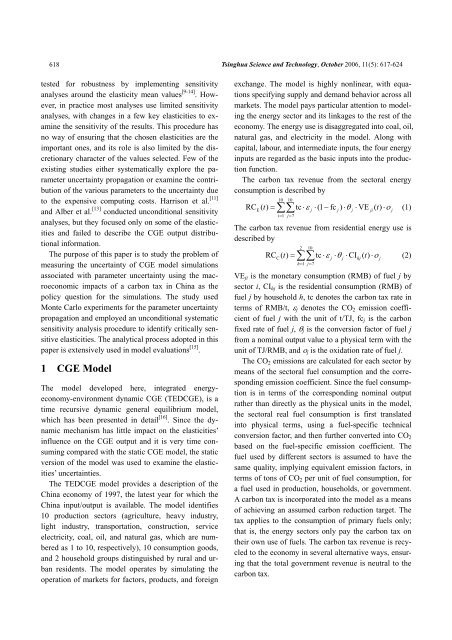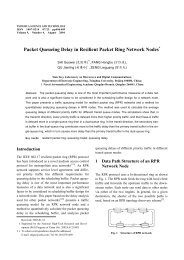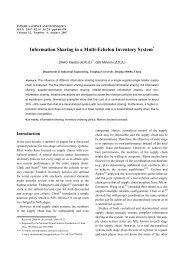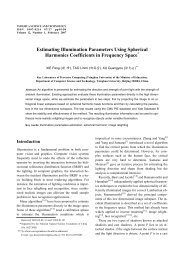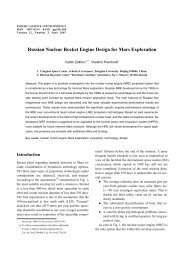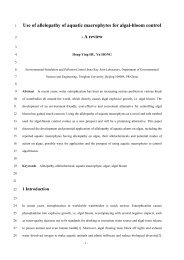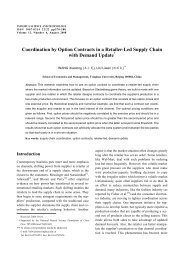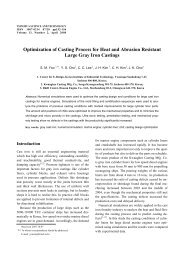Parameter Uncertainty in CGE Modeling of the Macroeconomic Impact
Parameter Uncertainty in CGE Modeling of the Macroeconomic Impact
Parameter Uncertainty in CGE Modeling of the Macroeconomic Impact
You also want an ePaper? Increase the reach of your titles
YUMPU automatically turns print PDFs into web optimized ePapers that Google loves.
618<br />
tested for robustness by implement<strong>in</strong>g sensitivity<br />
analyses around <strong>the</strong> elasticity mean values [9-14] . However,<br />
<strong>in</strong> practice most analyses use limited sensitivity<br />
analyses, with changes <strong>in</strong> a few key elasticities to exam<strong>in</strong>e<br />
<strong>the</strong> sensitivity <strong>of</strong> <strong>the</strong> results. This procedure has<br />
no way <strong>of</strong> ensur<strong>in</strong>g that <strong>the</strong> chosen elasticities are <strong>the</strong><br />
important ones, and its role is also limited by <strong>the</strong> discretionary<br />
character <strong>of</strong> <strong>the</strong> values selected. Few <strong>of</strong> <strong>the</strong><br />
exist<strong>in</strong>g studies ei<strong>the</strong>r systematically explore <strong>the</strong> parameter<br />
uncerta<strong>in</strong>ty propagation or exam<strong>in</strong>e <strong>the</strong> contribution<br />
<strong>of</strong> <strong>the</strong> various parameters to <strong>the</strong> uncerta<strong>in</strong>ty due<br />
to <strong>the</strong> expensive comput<strong>in</strong>g costs. Harrison et al. [11]<br />
and Alber et al. [13] conducted unconditional sensitivity<br />
analyses, but <strong>the</strong>y focused only on some <strong>of</strong> <strong>the</strong> elasticities<br />
and failed to describe <strong>the</strong> <strong>CGE</strong> output distributional<br />
<strong>in</strong>formation.<br />
The purpose <strong>of</strong> this paper is to study <strong>the</strong> problem <strong>of</strong><br />
measur<strong>in</strong>g <strong>the</strong> uncerta<strong>in</strong>ty <strong>of</strong> <strong>CGE</strong> model simulations<br />
associated with parameter uncerta<strong>in</strong>ty us<strong>in</strong>g <strong>the</strong> macroeconomic<br />
impacts <strong>of</strong> a carbon tax <strong>in</strong> Ch<strong>in</strong>a as <strong>the</strong><br />
policy question for <strong>the</strong> simulations. The study used<br />
Monte Carlo experiments for <strong>the</strong> parameter uncerta<strong>in</strong>ty<br />
propagation and employed an unconditional systematic<br />
sensitivity analysis procedure to identify critically sensitive<br />
elasticities. The analytical process adopted <strong>in</strong> this<br />
paper is extensively used <strong>in</strong> model evaluations [15] .<br />
1 <strong>CGE</strong> Model<br />
The model developed here, <strong>in</strong>tegrated energyeconomy-environment<br />
dynamic <strong>CGE</strong> (TED<strong>CGE</strong>), is a<br />
time recursive dynamic general equilibrium model,<br />
which has been presented <strong>in</strong> detail [16] . S<strong>in</strong>ce <strong>the</strong> dynamic<br />
mechanism has little impact on <strong>the</strong> elasticities’<br />
<strong>in</strong>fluence on <strong>the</strong> <strong>CGE</strong> output and it is very time consum<strong>in</strong>g<br />
compared with <strong>the</strong> static <strong>CGE</strong> model, <strong>the</strong> static<br />
version <strong>of</strong> <strong>the</strong> model was used to exam<strong>in</strong>e <strong>the</strong> elasticities’<br />
uncerta<strong>in</strong>ties.<br />
The TED<strong>CGE</strong> model provides a description <strong>of</strong> <strong>the</strong><br />
Ch<strong>in</strong>a economy <strong>of</strong> 1997, <strong>the</strong> latest year for which <strong>the</strong><br />
Ch<strong>in</strong>a <strong>in</strong>put/output is available. The model identifies<br />
10 production sectors (agriculture, heavy <strong>in</strong>dustry,<br />
light <strong>in</strong>dustry, transportation, construction, service<br />
electricity, coal, oil, and natural gas, which are numbered<br />
as 1 to 10, respectively), 10 consumption goods,<br />
and 2 household groups dist<strong>in</strong>guished by rural and urban<br />
residents. The model operates by simulat<strong>in</strong>g <strong>the</strong><br />
operation <strong>of</strong> markets for factors, products, and foreign<br />
Ts<strong>in</strong>ghua Science and Technology, October 2006, 11(5): 617-624<br />
exchange. The model is highly nonl<strong>in</strong>ear, with equations<br />
specify<strong>in</strong>g supply and demand behavior across all<br />
markets. The model pays particular attention to model<strong>in</strong>g<br />
<strong>the</strong> energy sector and its l<strong>in</strong>kages to <strong>the</strong> rest <strong>of</strong> <strong>the</strong><br />
economy. The energy use is disaggregated <strong>in</strong>to coal, oil,<br />
natural gas, and electricity <strong>in</strong> <strong>the</strong> model. Along with<br />
capital, labour, and <strong>in</strong>termediate <strong>in</strong>puts, <strong>the</strong> four energy<br />
<strong>in</strong>puts are regarded as <strong>the</strong> basic <strong>in</strong>puts <strong>in</strong>to <strong>the</strong> production<br />
function.<br />
The carbon tax revenue from <strong>the</strong> sectoral energy<br />
consumption is described by<br />
E<br />
10 10<br />
∑∑<br />
RC ( t) = tc ⋅ε⋅(1−fc ) ⋅θ ⋅VE ( t)<br />
⋅ο<br />
i= 1 j=<br />
7<br />
h= 1 j=<br />
7<br />
j j j ji j<br />
(1)<br />
The carbon tax revenue from residential energy use is<br />
described by<br />
2 10<br />
RC C ( t) = ∑∑ tc ⋅εj ⋅θj ⋅CI hj( t)<br />
⋅οj<br />
(2)<br />
VEji is <strong>the</strong> monetary consumption (RMB) <strong>of</strong> fuel j by<br />
sector i, CIhj is <strong>the</strong> residential consumption (RMB) <strong>of</strong><br />
fuel j by household h, tc denotes <strong>the</strong> carbon tax rate <strong>in</strong><br />
terms <strong>of</strong> RMB/t, εj denotes <strong>the</strong> CO2 emission coefficient<br />
<strong>of</strong> fuel j with <strong>the</strong> unit <strong>of</strong> t/TJ, fcj is <strong>the</strong> carbon<br />
fixed rate <strong>of</strong> fuel j, θj is <strong>the</strong> conversion factor <strong>of</strong> fuel j<br />
from a nom<strong>in</strong>al output value to a physical term with <strong>the</strong><br />
unit <strong>of</strong> TJ/RMB, and οj is <strong>the</strong> oxidation rate <strong>of</strong> fuel j.<br />
The CO2 emissions are calculated for each sector by<br />
means <strong>of</strong> <strong>the</strong> sectoral fuel consumption and <strong>the</strong> correspond<strong>in</strong>g<br />
emission coefficient. S<strong>in</strong>ce <strong>the</strong> fuel consumption<br />
is <strong>in</strong> terms <strong>of</strong> <strong>the</strong> correspond<strong>in</strong>g nom<strong>in</strong>al output<br />
ra<strong>the</strong>r than directly as <strong>the</strong> physical units <strong>in</strong> <strong>the</strong> model,<br />
<strong>the</strong> sectoral real fuel consumption is first translated<br />
<strong>in</strong>to physical terms, us<strong>in</strong>g a fuel-specific technical<br />
conversion factor, and <strong>the</strong>n fur<strong>the</strong>r converted <strong>in</strong>to CO2<br />
based on <strong>the</strong> fuel-specific emission coefficient. The<br />
fuel used by different sectors is assumed to have <strong>the</strong><br />
same quality, imply<strong>in</strong>g equivalent emission factors, <strong>in</strong><br />
terms <strong>of</strong> tons <strong>of</strong> CO2 per unit <strong>of</strong> fuel consumption, for<br />
a fuel used <strong>in</strong> production, households, or government.<br />
A carbon tax is <strong>in</strong>corporated <strong>in</strong>to <strong>the</strong> model as a means<br />
<strong>of</strong> achiev<strong>in</strong>g an assumed carbon reduction target. The<br />
tax applies to <strong>the</strong> consumption <strong>of</strong> primary fuels only;<br />
that is, <strong>the</strong> energy sectors only pay <strong>the</strong> carbon tax on<br />
<strong>the</strong>ir own use <strong>of</strong> fuels. The carbon tax revenue is recycled<br />
to <strong>the</strong> economy <strong>in</strong> several alternative ways, ensur<strong>in</strong>g<br />
that <strong>the</strong> total government revenue is neutral to <strong>the</strong><br />
carbon tax.


